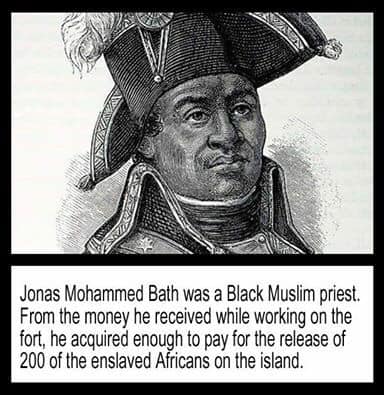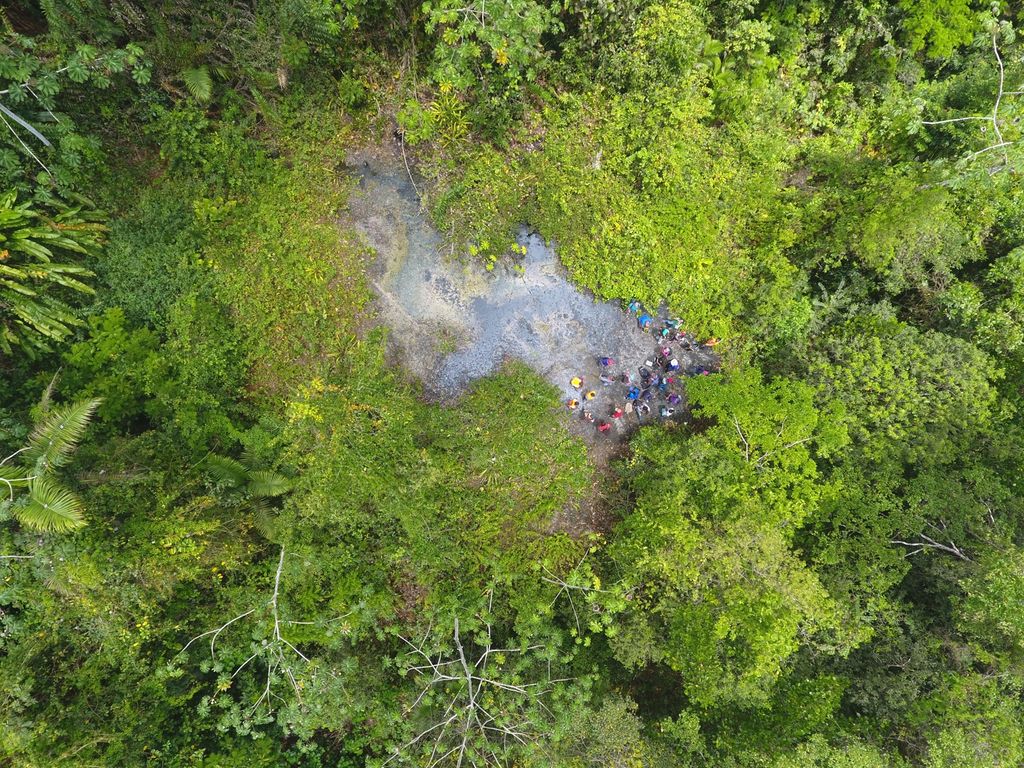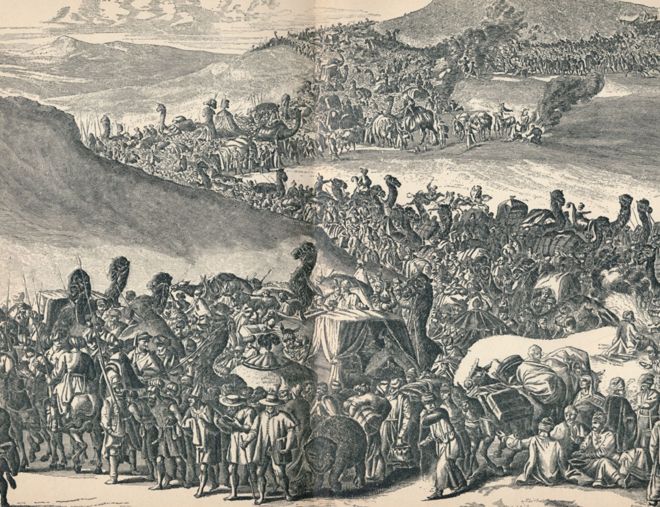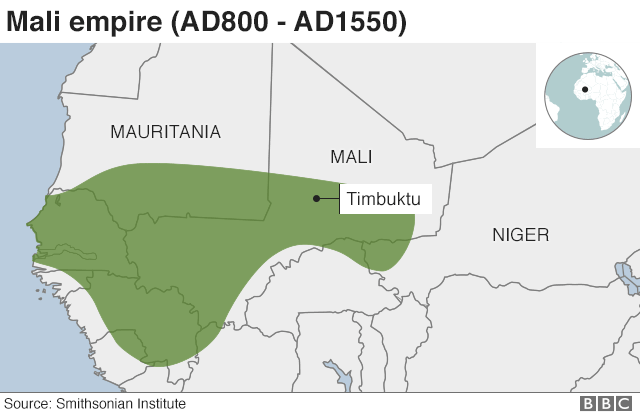|
This is the man after whom Bath Street, off Picadilly Street, East Port-of-Spain, was named.
He was Jonas Mohammed Bath, a Mandingo Muslim priest and member of the Koramantyn tribe in Africa who claimed to be the Sultan of Yulliallhad Alimant Animan. Bath arrived in Trinidad in 1805 as an enslaved African, and was put to work on the construction of Fort George, Port-of-Spain. He constructed a five-mile uphill road and, at the top, established battlements on what was later known as Fort George. As an Imam regarded as a patriarch, Bath had influence over his fellow Muslims working on the construction of the fort, so he was appointed as an overseer or “colonial negro” with pay. From the money he received while working on the fort, he acquired enough to pay for the release of 200 of the enslaved Africans on the island. Bath, who was founder of the Mandingo Freedom Society, set up a sou-sou to purchase the freedom of his African brethren. After the completion of the fort, he purchased several acres of land at Santa Cruz Valley, which he named Mizra Estate (after the Arabic word for a country estate). In the 1830s, Bath wrote several petitions in English and Arabic on behalf of other Muslims who wished to be repatriated to their native lands. This goal, complicated under British law, was achieved to some degree. Several of his followers did make their way back home. Bath died in September 1838, one month after the emancipation of the enslaved Africans in Trinidad. Source: Dominic Kalipersad  Today, the San Fernando City Corporation recognized Pan extraordinaire, Lennox Bobby Mohamed, by renaming Harris Promenade East after him. This gesture was done in recognition of his outstanding contribution to the steel-band art form. Bobby was a game changer and trailblazer, producing a style of music in the 1960s that was unheard of, but no doubt infectious. He brought victory to the southland in 1965 and 1967 as he became the youngest arranger in the history of the competition to win a Panorama title, which he did with his arrangement for the San Fernando-based band Guinness Cavaliers This area was called Coolie Town when former Indian indentured labourers settled there after the expiration of their their five-year contracts.
By the 1890s the area expanded to eventually become what is now known as St James. The new name was apparently taken from the main street through the area - St James Street (which became Tragarete Road). St James Street got its name from the nearby St James Barracks. Other street names recognised the nationality of the inhabitants. Therefore, Delhi Street, Agra Street etc. Coolie Town had emerged on an area that Sir Ralph Abercromby had landed his troops to seize Trinidad from the Spanish in 1797. The estate became the property of the Devinish family who, by the 1850s, sold tracts of land to merchant families like the Stones and Salazars. It was during that period that Indian labourers began to arrive to work on plantations. From about 1870, the area started to be called Coolie Town as the Indian labourers whose contracts had ended began renting estate lands for farming. Among them were craftsmen, including jewelers whose work made the area commercially popular. St James was incorporated in the City of Port-of-Spain in 1917. Source: Dominic Kalipersad, March 2019 Deep in the Trinity forests about 13 miles from the coast lies one of T&T's best-kept secrets—a warm salt water volcano or salt spring, possibly the only one of its kind in the world.
Salt Spring—the Rio Claro Salt Water Volcano—was recorded in a publication in 1959 by Swiss geologist Dr Hans Kugler, but it was only two years ago a team of 37 geologists went back to the site, defining it and making it known publicly. Despite this, the volcano remains under-explored to many citizens. The rocks around the volcano are spongy beneath your feet. A coral-like formation known as "tufa" exists on the flanks of the volcano, which plunges around 250 feet downhill to meet the salt water river in the area, which is devoid of vegetation. Researchers have been trying to ascertain why the water which flows from the volcano is salty, seeing that the nearest coast is 25 kilometres away. Around 100 feet from the salt water volcano is a major oil seep, which also flows down toward the salt water river. Senior geoscientist at Touchstone Exploration Xavier Moonan, who has been investigating the mysterious natural wonder, believes the outflow is actually trapped sea water coming from a Cretaceous reservoir dating 65 million years ago. In an exclusive interview with Guardian Media, Moonan said the warm salt water emerges from the ground as a natural seep similar to mud volcanoes in other parts of the country. "Accompanied by some oil, the salty water constantly flows and cascades radially down the hillside where the small streams merge to form Salt River. Salt River flows generally northward where it eventually merges with the larger Ortoire River that empties into the Atlantic on the east coast near Mayaro," Moonan said. It was hunters who first came upon the volcano, which when viewed from drones appears as a whitish expansive puddle completely surrounded by dense tropical forest. Moonan said the small hillside of very active oil and salt water seeps drew geologists by the droves. "The American Association of Petroleum Geologists Young Professionals Trinidad and Tobago Chapter (AAPGYPTT) visited the site on a number of occasions, sampling the rocks, water, and oil emanating from the ground," Moonan said. Noting that this site is quite unique, and quite possibly the only of its kind in the world, Moonan said it was much more than just another oil and salt water seep. "Our very own La Brea Pitch Lake, for instance, is one of the largest natural oil seeps in the world. This Salt Water volcano is unique. We believe the salt water flow comes from trapped seawater flowing from an ancient Cretaceous reservoir," Moonan said. He said proof of this comes from the results of an exploration well drilled by Exxon in the 1990s which showed a number of limestone-rich zones in the area which dates to the Cretaceous age. The rocks were found at depths of approximately 5,500 feet, Moonan explained. Closer examination of the "crunchy" rocks identified then as a carbonate deposit called tufa. "It is generally grey to white and appears spongy in parts. They are very similar to the limestone deposits at Turure Watersteps in the Northern Range, which make up the walls of each terrace. At Turure the carbonate is being actively reprecipitated out of the river water. It is enriched in carbonate due to limestone rocks along the river tributaries further up the mountain," Moonan said. "Based on the geological evolution of the Guayaguayare area, we strongly believe that the source of the carbonate for tufa precipitation comes from Cretaceous rocks, and furthermore, the saline waters which feed the Salt River are very likely being expelled from Cretaceous reservoirs as well," Moonan explained. Like the Pitch Lake of La Brea and our many other mud volcanoes, Moonan believes the Salt Water volcano could generate mass foreign exchange to the country at a time when the economy is in shambles. "In other parts of the world, a feature such as this would be significantly developed and marketed as a natural spa," he said. "Companies such as Range Resources and Touchstone Exploration, who are actively exploring these areas for hydrocarbons have to date significantly supported the expeditions, testing and geological understanding of the feature," he said. Getting to the volcano is not easy and only an experienced tour guide can get you there. It takes two hours southward from the Trinidad Controlled Oilfield (TCO) Duckham Road, through very thick forest, to come upon the volcanic site. Downstream from the salt water volcano, the Salt River crosses the Duckham Road, heading northeast to join the Poole River. "Though its salinity has dropped from 23,000 ppm at the source to a brackish 6,000 ppm some 2.5 kilometres downstream, people can revel in this natural geologic phenomenon," Moonan said. "With the right vision a good synergy of the science from the companies and marketing from the Regional Corporation, the Salt Water volcano can become a new geotouristic site that can redound in jobs and development for the people of Rio Claro, Guayaguayare," he added. Minister of Agriculture Clarence Rambharat who accompanied the team of geologists on the historic 2017 expedition to the volcano agreed that the volcano had the potential for tourism. Chairman of the Mayaro Rio Claro Regional Corporation Glen Ram said that in 1959, Dr Hans Kugler recorded this feature as a salt spring in his work Surface Geology Map of Trinidad. Ram said with proper assistance, the Rio Claro Salt Water volcano could be developed into an international tourist site. He said the Corporation was willing to print brochures on the volcano to educate the population about its wonders once it receives funding from the Central Government. Source: The Guardian, March 2019 Mansa Musa travelled to Mecca with a caravan of 60,000 men and 12,000 slaves Amazon founder Jeff Bezos is the richest man in the world, according to the 2019 Forbes billionaires' list released this week. With an estimated fortune of $131bn (£99bn) he is the wealthiest man in modern history. But he is by no means the richest man of all time. That title belongs to Mansa Musa, the 14th Century West African ruler who was so rich his generous handouts wrecked an entire country's economy. "Contemporary accounts of Musa's wealth are so breathless that it's almost impossible to get a sense of just how wealthy and powerful he truly was," Rudolph Butch Ware, associate professor of history at the University of California, told the BBC. Mansa Musa was "richer than anyone could describe", Jacob Davidson wrote about the African king for Money.com in 2015. In 2012, US website Celebrity Net Worth estimated his wealth at $400bn, but economic historians agree that his wealth is impossible to pin down to a number. The 10 richest men of all time
The golden kingMansa Musa was born in 1280 into a family of rulers. His brother, Mansa Abu-Bakr, ruled the empire until 1312, when he abdicated to go on an expedition. According to 14th Century Syrian historian Shibab al-Umari, Abu-Bakr was obsessed with the Atlantic Ocean and what lay beyond it. He reportedly embarked on an expedition with a fleet of 2,000 ships and thousands of men, women and slaves. They sailed off, never to return. Some, like the late American historian Ivan Van Sertima, entertain the idea that they reached South America. But there is no evidence of this. In any case, Mansa Musa inherited the kingdom he left behind. Under his rule, the kingdom of Mali grew significantly. He annexed 24 cities, including Timbuktu. The kingdom stretched for about 2,000 miles, from the Atlantic Ocean all the way to modern-day Niger, taking in parts of what are now Senegal, Mauritania, Mali, Burkina Faso, Niger, The Gambia, Guinea-Bissau, Guinea and Ivory Coast. With such a large land mass came great resources such as gold and salt.
During the reign of Mansa Musa, the empire of Mali accounted for almost half of the Old World's gold, according to the British Museum. And all of it belonged to the king. "As the ruler, Mansa Musa had almost unlimited access to the most highly valued source of wealth in the medieval world," Kathleen Bickford Berzock, who specializes in African art at the Block Museum of Art at the Northwestern University, told the BBC. "Major trading centres that traded in gold and other goods were also in his territory, and he garnered wealth from this trade," she added. The journey to MeccaThough the empire of Mali was home to so much gold, the kingdom itself was not well known. This changed when Mansa Musa, a devout Muslim, decided to go on a pilgrimage to Mecca, passing through the Sahara Desert and Egypt. The king reportedly left Mali with a caravan of 60,000 men. He took his entire royal court and officials, soldiers, griots (entertainers), merchants, camel drivers and 12,000 slaves, as well as a long train of goats and sheep for food. It was a city moving through the desert. A city whose inhabitants, all the way down to the slaves, were clad in gold brocade and finest Persian silk. A hundred camels were in tow, each camel carrying hundreds of pounds of pure gold. It was a sight to behold. And the sight got even more opulent once the caravan reached Cairo, where they could really show off their wealth. The Cairo gold crashMansa Musa left such a memorable impression on Cairo that al-Umari, who visited the city 12 years after the Malian king, recounted how highly the people of Cairo were speaking of him. So lavishly did he hand out gold in Cairo that his three-month stay caused the price of gold to plummet in the region for 10 years, wrecking the economy. US-based technology company SmartAsset.com estimates that due to the depreciation of gold, Mansa Musa's pilgrimage led to about $1.5bn (£1.1bn) of economic losses across the Middle East. On his way back home, Mansa Musa passed through Egypt again, and according to some, tried to help the country's economy by removing some of the gold from circulation by borrowing it back at extortionate interest rates from Egyptian lenders. Others say he spent so much that he ran out of gold. Lucy Duran of the School of African and Oriental Studies in London notes that Malian griots, who are singing historian storytellers, in particular, were upset with him. "He gave out so much Malian gold along the way that jelis [griots] don't like to praise him in their songs because they think he wasted local resources outside the empire," she said. Education at heartThere is no doubt that Mansa Musa spent, or wasted, a lot of gold during his pilgrimage. But it was this excessive generosity that also caught the eyes of the world. Mansa Musa had put Mali and himself on the map, quite literally. In a Catalan Atlas map from 1375, a drawing of an African king sits on a golden throne atop Timbuktu, holding a piece of gold in his hand. Timbuktu became an African El Dorado and people came from near and far to have a glimpse. In the 19th Century, it still had a mythical status as a lost city of gold at the edge of the world, a beacon for both European fortune hunters and explorers, and this was largely down to the exploits of Mansa Musa 500 years earlier. Mansa Musa returned from Mecca with several Islamic scholars, including direct descendants of the prophet Muhammad and an Andalusian poet and architect by the name of Abu Es Haq es Saheli, who is widely credited with designing the famous Djinguereber mosque. The king reportedly paid the poet 200 kg (440lb) in gold, which in today's money would be $8.2m (£6.3m). In addition to encouraging the arts and architecture, he also funded literature and built schools, libraries and mosques. Timbuktu soon became a centre of education and people travelled from around the world to study at what would become the Sankore University. The rich king is often credited with starting the tradition of education in West Africa, although the story of his empire largely remains little known outside West Africa. "History is written by victors," according to Britain's World War II Prime Minister Winston Churchill. After Mansa Musa died in 1337, aged 57, the empire was inherited by his sons who could not hold the empire together. The smaller states broke off and the empire crumbled. The later arrival of Europeans in the region was the final nail in the empire's coffin. "The history of the medieval period is still largely seen only as a Western history," says Lisa Corrin Graziose, director of the Block Museum of Art, explaining why the story of Mansa Musa is not widely known. "Had Europeans arrived in significant numbers in Musa's time, with Mali at the height of its military and economic power instead of a couple hundred years later, things almost certainly would have been different," says Mr Ware. Source: BBC News, March 2019 |
T&T news blogThe intent of this blog is to bring some news from home and other fun items. If you enjoy what you read, please leave us a comment.. Archives
May 2025
Categories
All
|






 RSS Feed
RSS Feed